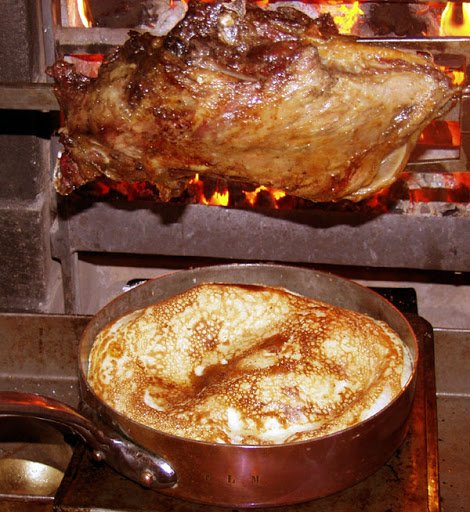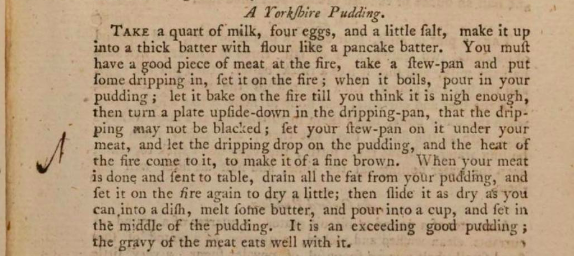History of Food: Yorkshire Pudding
By Saiba Haque, Third Year Politics and Philosophy
The Bristorian Magazine and The Croft Magazine (University of Bristol’s Lifestyle magazine) presents you with a special collaboration article. We bring to you, the History of Food. This collaboration article focuses on the History of the Yorkshire puddings. The Historical breakdown of Yorkshire puddings is provided in this article. For recreation of both historical and present day recipes of Yorkshire pudding visit the Croft (Food) site here.
This Christmas Eve, I was shopping in the grocery store for a last-minute Christmas dinner. While I shopped, I was able to find almost everything I needed for the dinner, with a stark exception of Yorkshire puddings. They were sold out completely in every store near me. Every single year there’s a person like myself who does last-minute grocery shopping for Christmas and loses out on securing themselves Britain’s favourite, most loved side dish-evidenced by its overwhelming demand. I can’t help but wonder, how did Britain’s most popular side dish come about? Let’s dive into the History of Yorkshire Pudding.
When one mentions pudding, the immediate thought may be that of a sweet dessert. However, originally puddings were a meat-based, sausage-like food in Britain, with black pudding as an example. Often offal and less desirable parts were used in making them. However, around the late eighteenth century there were mentions of puddings that were no longer only meat-based, but also a version where the word ‘pudding’ became synonymous with ‘batter’. The ‘Batter’ from these mentions consisted of the basic ingredients of flour, milk, eggs and sometimes included salt, butter, suet, sugar, cinnamon, ginger, pepper, cloves, nutmeg etc.
The first published recipe for an early rendering of what we now know as the Yorkshire pudding was initially printed in a manuscript-like guidebook for English Women to know about their duty. In 1737, The Whole Duty of a Woman, Or, an infallible Guide to the Fair Sex. Containing, Rules, Directions, and Observations, for their Conduct and Behavior through all Ages and Circumstances of Life, as Virgins, Wives, or Widows. was published anonymously. Within this ever so comprehensive guide consisting of almost every exhortation imaginable for the ‘benefit’ of women at the time, there exists recipes of various dishes; one of them being a recipe for “Dripping Pudding” which is meant to accompany and cook with meat.
Author: Anonymous. Available to read in Google Books.
However, although this recipe was published, the publication itself did not achieve a wide circulation. Nevertheless, a decade later in 1747, English cooking writer, Hannah Glasse, published The Art of Cookery Made Plain and Easy. In this edition, Glasse, who is native to Yorkshire, published her own recipe for “Dripping Pudding” which she titled as “Yorkshire Pudding”. Glasse’s book sold well throughout the country and the Yorkshire pudding remained to be a regularly enjoyed dish in many British homes, with it being most popular in the Northern Shires.
Author: Hannah Glasse. Available to read in Google Books
With “Dripping Pudding” being the origin of the Yorkshire pudding, the purpose of the dish is in its name, as the batter would serve to utilise the hot drippings (fat) from the meat instead of losing it over the fire when cooking. As meat was immensely expensive throughout the eighteenth century, households had to make sure that no parts of the meat were wasted. This fat not only provided rich flavours, but also provided the much-needed calories required, particularly for men doing manual labour. Nowadays, Yorkshire Puddings are more readily available in stores or easy to make through pantry or shelf stable ingredients alone.
Traditionally the Yorkshire pudding was not served with or alongside the roasted meat. Rather, it was served before the main meal as an appetiser, with the pudding was cut into smaller portions and doused with gravy. The general perception was that it was done this way to fill up on the appetite before the main meal, so that diners were more satisfied with smaller portions of more expensive meat. Although Yorkshire pudding can be made with any roasting meat, the Englishmen of the eighteenth had a particular fondness for roast beef. Therefore, by the nineteenth century, roast beef and Yorkshire pudding had become a quintessential British meal throughout many households in England.
Featured Image By Foods of England




